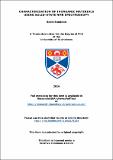Characterisation of inorganic materials using solid-state NMR spectroscopy
Abstract
This thesis uses solid-state nuclear magnetic resonance (NMR) spectroscopy and density functional theory (DFT) calculations to study local structure and disorder in inorganic materials. Initial work concerns microporous aluminophosphate frameworks, where the importance of semi-empirical dispersion correction (SEDC) schemes in structural optimisation using DFT is evaluated. These schemes provide structures in better agreement with experimental diffraction measurements, but very similar NMR parameters are obtained for any structures where the atomic coordinates are optimised, owing to the similarity of the local geometry. The ³¹P anisotropic shielding parameters (Ω and κ) are then measured using amplified PASS experiments, but there appears to be no strong correlation of these with any single geometrical parameter.
In subsequent work, a range of zeolitic imidazolate frameworks (ZIFs) are investigated. Assignment of ¹³C and ¹⁵N NMR spectra, and measurement of the anisotropic NMR parameters, enabled the number and type of linkers present to be determined. For ¹⁵N, differences in Ω may provide information on the framework topology. While ⁶⁷Zn measurements are experimentally challenging and periodic DFT calculations are currently unreliable, calculations on small model clusters provide good agreement with experiment and indicate that ⁶⁷Zn NMR spectra are sensitive to the local structure.
Finally, a series of pyrochlore-based ceramics (Y₂Hf₂₋ₓSnₓO₇) is investigated. A phase transformation from pyrochlore to a disordered defect fluorite phase is predicted, but ⁸⁹Y and ¹¹⁹Sn NMR reveal that rather than a solid solution, a significant two-phase region is present, with a maximum of ~12% Hf incorporated into the pyrochlore phase. The use of ¹⁷O NMR to provide insight into the local structure and disorder in these materials is also investigated. Once the different T₁ relaxation and nutation behaviour is considered it is shown that quantitative ¹⁷O enrichment of Y₂Sn₂O₇ is possible, and that ¹⁷O does offer a promising future tool for study.
Type
Thesis, PhD Doctor of Philosophy
Rights
Creative Commons Attribution-NoDerivatives 4.0 International
http://creativecommons.org/licenses/by-nd/4.0/
Collections
Except where otherwise noted within the work, this item's licence for re-use is described as Creative Commons Attribution-NoDerivatives 4.0 International
Items in the St Andrews Research Repository are protected by copyright, with all rights reserved, unless otherwise indicated.


